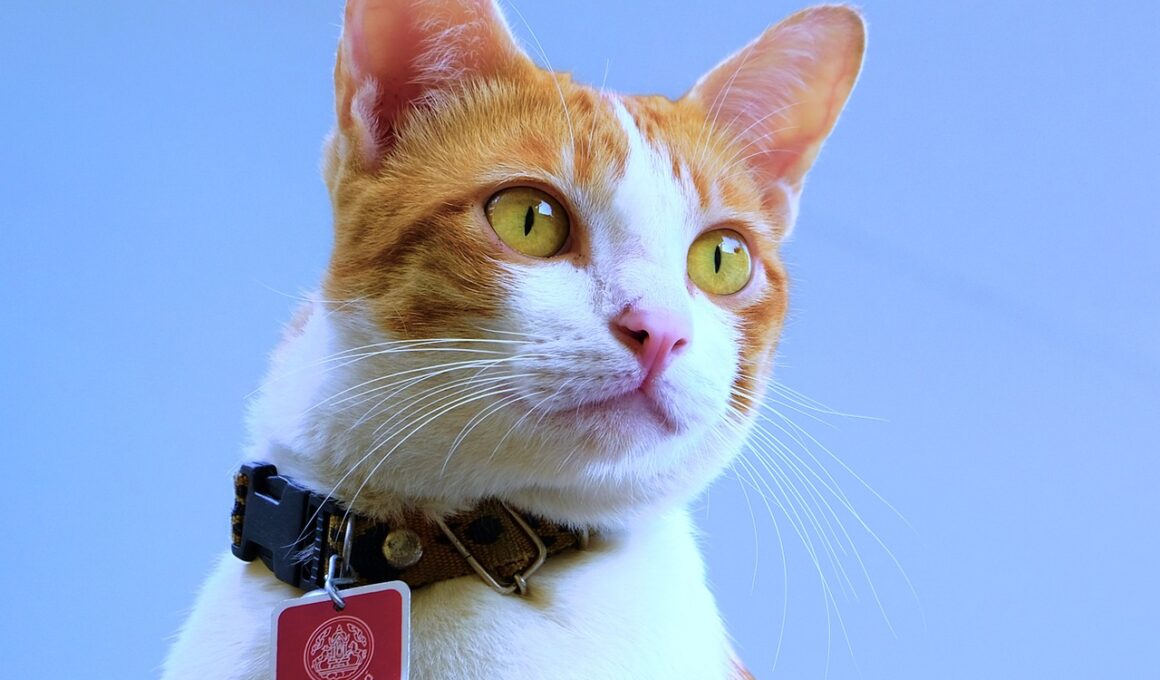How to Properly Fit a Collar on Your Cat to Ensure Comfort and Safety
Fitting a collar on your cat is essential for their safety. A collar not only allows for identification but also carries potential hazards if not fitted correctly. It’s vital to assess the correct size to ensure comfort and avoid injuries. Start by measuring the circumference of your cat’s neck using a flexible measuring tape. Ensure the tape is snug yet not tight, allowing for a two-finger gap between the collar and pet’s neck. This verification minimizes the risk of choking or irritation. After measuring, it’s equally important to consider the collar type. Many options come in various materials, including nylon and leather. Choose a collar with breakaway features to ensure safety when playing with other animals or getting caught on an object. Regularly check the collar’s fit as your cat ages or gains weight. Remember, adjusting fitting is crucial; it ensures your pet’s comfort, safety, and security. If the collar is too loose, it might slip off easily, leading to potential loss. Alternatively, if it’s too tight, discomfort may arise, causing stress and behavioral issues with your cat.
The Importance of Choosing the Right Collar
The specific design of the collar plays a significant role in its effectiveness. There are various types of collars available; each serves distinct purposes. For instance, a standard collar is suitable for everyday use, offering identification tags for your cat. These tags can include your contact details to facilitate quick returns if your pet goes missing. Moreover, some cats may require flea and tick collars that serve dual purposes. Alternatively, during outdoor adventures, breakaway collars prevent choking hazards by releasing when significant force is applied. When selecting your collar, prioritize durable materials that withstand daily wear. Nylon collars, for example, are lightweight and resistant to various weather conditions. Leather collars are typically robust yet stylish, appealing to many cat owners. Invest in a collar that combines safety with aesthetics, ensuring it suits your pet’s personality. Always regularly examine your cat’s collar for signs of wear and replace it when necessary. Assessing your cat’s comfort regarding collar fit, design, and texture is crucial for promoting their willingness to adapt. Engaging with your cat positively during this adaptation fosters trust, making it easier to keep your feline secure.
Before putting on the collar, familiarize your cat with the new item. Allow them to sniff and explore the collar in a calm environment. This practice lessens anxiety and prepares them for the fitting process. Choose a quiet area without distractions for fitting. Gently hold your cat in a way that maintains comfort and security. Engage them with soothing voices or gentle petting during the process. Gradually slip the collar around their neck while ensuring the collar’s position is comfortable. There are cases where a hesitant cat may resist putting on a collar. In such instances, keep the collar near their bedding or feeding areas to promote familiarization. This technique can gradually reduce anxiety associated with wearing it. Once the collar is on, ensure to reward them with treats or a favorite toy, reinforcing positive associations with the experience. Take a few moments to observe how your cat reacts while wearing the collar. If they show signs of distress, take it off and try again later. Patience is essential; it may take multiple attempts before your cat is comfortable wearing a collar without signs of irritation.
Regular Inspection and Maintenance
Ongoing maintenance of your cat’s collar is essential for ensuring longevity and safety. Regularly check for wear and tear signs, including fraying or fading materials. These signs indicate it might be time for a replacement. Inspect the buckle and fastenings to ensure they function correctly. A damaged buckle can lead to potential escape, making regular checks crucial. Another essential aspect of maintenance is adjusting the fit as your cat grows or loses weight. Periodically revisiting the collar size ensures it’s neither too tight nor too loose. Keeping the collar clean is equally important; dirt and grime can irritate your cat’s skin. Use a damp cloth to wipe down the collar, ensuring it’s refreshed and hygienic. If your cat spends time outdoors, consider running the collar through a gentle wash occasionally. However, ensure to follow the manufacturer’s cleaning instructions to avoid damage. You can ensure your collar remains functional and comfortable with a regular maintenance routine. Maintaining a safe and secure collar allows you to build a stronger bond with your pet and give them the freedom to explore their environment without worry.
It’s crucial to educate yourself on local pet laws and regulations regarding collars. Some jurisdictions may require specific identification standards, urging pet owners to ensure collar compliance with these mandates. Knowing the local requirements can help guide you in selecting the best collar for your feline friend. Additionally, consider tagging practices that reflect current contact information. This information can enhance the chances of a swift reunion should your cat wander off. Many pet owners opt for microchipping as an alternative identification method, but collars should not be overlooked. Microchips are beneficial, but they need scanning, while visible tags make identification easier. Balance visible identification with digital methods for peace of mind. A collar adorned with laminated ID tags can include crucial information, such as your phone number, ensuring a quick return. Engaging with local communities focused on lost pets can also be proactive. Sharing awareness with your neighbors can enhance the safety net surrounding your pet. Effective community involvement strengthens your pet’s safety network, benefitting you, your feline, and your neighbors alike. Ensuring proper collar integration with educational advancements maximizes your cat’s comfort and identification.
Potential Risks and Considerations of Collar Use
While collars provide various advantages, it’s essential to acknowledge potential risks associated with their use. The most significant risk occurs if the collar becomes caught on something, particularly during play or exploration. This situation can lead to choking or serious injury. Choosing the appropriate collar design, like breakaway collars, can significantly reduce these risks. If your cat spends considerable time outdoors, identify potential hazards in the environment. Avoid areas with objects they could get caught on, such as low branches and fences. Another consideration is the possibility of skin irritation resulting from prolonged collar wear. Some cats may develop allergies to materials used in collars, thus opting for hypoallergenic materials can have benefits. Regularly inspect the area where the collar rests on their neck to identify signs of irritation or discomfort. Immediate removal may be necessary if irritation occurs. Pay attention to your cat’s behavior, as reluctance to wear the collar can indicate discomfort. Holistic approaches to integration may also involve consulting your veterinarian for personalized recommendations in relation to collar use and bird safety.
As pet parents, ensuring your cat’s safety involves understanding how to select and maintain their collar effectively. Equip yourself with knowledge to choose the most suitable collar for your feline. Researching various brands, styles, and safety features can provide deeper insights into the right choice. Take time to evaluate each feline’s unique personality, activity level, and environment, tailoring the collar choice. Additionally, consider the color and style that resonates with you as an owner, showcasing your cat’s personality. Engaging with fellow pet parents can also yield valuable information and experiences surrounding collar use, from success stories to learning opportunities. Building a community can ensure more reliable knowledge sharing. To end, commit to constant learning regarding your cat’s collar. Stay updated with advancements in collar technology, including improved safety features designed to protect your feline better. Regular engagement ensures you’re equipped with the latest information. Making informed decisions leads to your cat’s happiness and minimizes any collateral risks associated with collar use. Your commitment to your cat’s safety fosters a safe environment that keeps your cat confident and secure, enhancing their quality of life.


